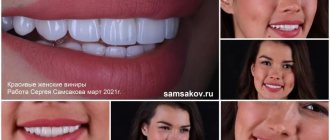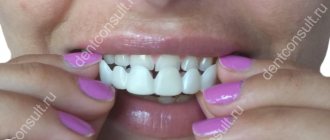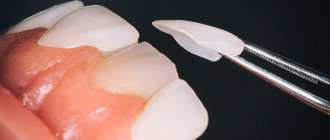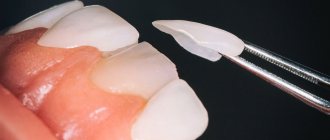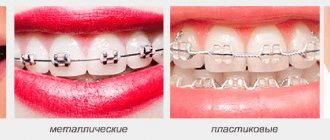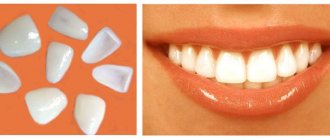What are composite veneers and their composition
Composite (direct) veneers are special overlays on the front surface of the teeth, which are made from composite materials in the patient’s mouth. The reflective material is applied in layers directly to the surface of the teeth. One visit to the dentist is enough to complete the procedure.
A composite is a spatial three-dimensional combination of two or more chemical substances, in which there is a clear interface - it can be seen even with the naked eye. This combination enhances the properties of each component several times.
The first composite materials entered the dental market in 1964, but since then they have evolved, becoming more convenient and safer for humans, because during this period:
- new adhesives were created;
- the color scheme was improved;
- the strength of materials increased.
The main components of a modern composite:
- polymer matrix consisting of:
- polymerization inhibitor, which increases the shelf life of the substance;
- main and additional catalyst;
- activator;
- an ultraviolet absorber that prevents the color of the linings from changing when exposed to sunlight;
- inorganic filler, thanks to which:
- the aesthetic properties of microprostheses are increased, since the mineral filler has physical characteristics close to natural teeth;
- material deformation is prevented;
- the hardness and resistance of the composite increases;
- Surfactants or silanes are organosilicon compounds that increase the strength of the material.
Of these three components, the properties and differentiation of the composite are most influenced by fillers, which are classified based on the following characteristics:
- according to the material:
- from quartz;
- from silicon dioxide;
- from diamond dust;
- made of barium glass;
- According to the size of filler particles, there are composites from 0.04 to 45 microns;
- by particle shape:
- sticks;
- antennae;
- spirals;
- shavings;
- dust;
- ground.
Most dental composites used to make veneers are primarily composed of ground barium glass particles, but much depends on the manufacturer.
Classification of composite onlays for teeth
Composite veneers are classified based on the number and size of particles they contain. According to this criterion, composite linings are divided into:
- cheap veneers with large composite particles (more than 30 microns): they quickly fade and cannot be further processed;
- overlays with mini-filler and particles up to 1.5 microns;
- hybrid composite veneers with particles measuring about 1 micron;
- microprostheses with microparticles (up to 0.04 microns), used exclusively to restore the aesthetic appearance of the front teeth.
Main advantages
- Affordable price. The cost of composite products is lower than ceramic products.
- The preparation of tooth tissue for composite veneers is minimal and does not affect the deeper sensitive layers.
- Composite veneers are installed in one visit to a dentist at a medical clinic.
- The products completely match the color of the enamel of the patient’s own teeth.
Indications for installation
Veneers made of composite material perfectly mask the following dental defects:
- abnormal shape of teeth;
- dental chips;
- wide spaces between teeth;
- uneven contours of the front teeth;
- displacement of crowns in the vertical plane;
- yellow or gray spots on the enamel that cannot be bleached;
- age-related change in enamel shade;
- thinning teeth;
- defect of the filling material: change in color of the filling, slight chipping;
- increased wear of crowns.
The installation of veneers is indicated if it is necessary to visually correct the condition of several teeth in the smile area. But in case of significant defects, it is more advisable to use other dental methods for correcting the dentition.
Contraindications for installation
Direct veneering is contraindicated in the following cases:
- insufficient oral hygiene, as there is a high risk of developing caries directly under the linings;
- the presence of carious cavities;
- malocclusion and the need to wear braces;
- the presence of inflammatory processes in the mouth;
- bruxism;
- tooth mobility;
- erupting wisdom tooth;
- the presence of pulpless dental units, as they are more prone to destruction;
- serious enamel defects.
If the listed pathologies are eliminated, anyone can get direct composite veneers, and they will last for quite a long time.
Reviews
If you read reviews of direct veneers from the websites Otzovik and IRecommend , you can be convinced of the short service life of the structure. After several years of wearing a photopolymer overlay, it is still necessary to install a ceramic veneer, as chipping and tarnishing are inevitable. Straight cladding deteriorates especially quickly among smokers and coffee drinkers, because... absorb brown pigment.
The integrity and wearing period of direct veneers also greatly depends on the bite . People with straight bites usually leave negative reviews of direct composite veneers because... quickly chop off the extended cutting edge. With normal and distal occlusion, on the contrary, the linings can be worn longer, because the load on the upper front teeth is minimal.
The chosen material is also important. The best results in terms of strength and aesthetics are shown by the latest generation materials - nanohybrid composites with a high degree of filling and low shrinkage. These are photopolymers such as:
- Estelite (Japan);
- Enamel plus (Italy);
- Filtek (USA).
When choosing a doctor, make sure that he has previously used the direct composite veneer method; for this, ask for a portfolio of work. After completing the procedure, do not forget to follow the recommendations: give up bad habits, do not gnaw hard foods with your front teeth.
Also, in the first week after installation, you should completely give up tea, coffee, juices , because... It is at this time that dyes from the oral cavity are most absorbed. If chips occur, you should contact the same doctor, who will carry out restoration free of charge during the warranty period (1 year).
Advantages and disadvantages of veneering
The main advantages of composite veneers include:
- speed of production and installation: you don’t even need to make additional impressions;
- durability subject to proper use and quality care;
- beautiful appearance;
- maximum naturalness: modern composite materials transmit light well.
But composite veneers also have disadvantages:
- relative fragility, which manifests itself if a person does not take care of the pads and does not use suitable personal hygiene products;
- slight masking ability, which manifests itself in the presence of teeth that are too dark in color or bright, prominent spots (due to tetracycline);
- the need to grind down the enamel: after removing the veneers, the teeth need to be restored.
If only the central and lateral incisors are restored using veneering, then the remaining teeth often have to be whitened.
The quality of installation of veneer microprostheses depends on the skill of the dentist. Not all dentists can beautifully install veneers, so before installing them, it is recommended to check with the doctor about his track record and ask for photos of the work he has performed.
You should also pay attention to the cost of veneers, since professionals do not work at minimum prices. The approximate average cost of one direct composite veneer in Moscow and St. Petersburg is 8–9 thousand rubles. for one tooth . Minimum prices for composite veneers start from 4 thousand 500 rubles. Veneering is not covered by compulsory medical insurance, as it is a cosmetic procedure.
Popular questions
- Is turning necessary? Is it possible to install composite veneers without grinding?
Comparison of lumineer and lens thickness
Turning simulates the desired tooth shape, and in addition, an onlay without turning will look unnaturally wide and spoil the appearance. Turning is a necessary procedure.
However, there is a method of dental prosthetics that allows you to avoid grinding down the enamel at all. This method involves the use of lumineers, a thin plate whose width is only a few tenths of a millimeter. The price of such prostheses is significantly higher than average, and more durable materials are used in their manufacture.
- How are composite veneers different from ceramic veneers?
Ceramic plates are made of a different material. They are more expensive, but both the quality and shelf life correspond to the price.
- How to bleach them?
It is recommended that any veneers be whitened in a dental clinic with the help of a specialist.
- Is it worth installing?
It is definitely worth installing if the teeth need correction, and after consultation with a dentist, no contraindications were found.
- In what cases is replacement needed?
Replacement is necessary if the veneers have acquired a different shade or begun to crumble or crack. Replacement must be carried out without delay, and this must be done by a specialist.
- Is it possible to put composite veneers on crowns?
Attaching such an overlay to a crown is a complex procedure, especially since the structure is fragile. Experts do not recommend attaching dentures to crowns. Despite this, each case is individual. Even if the option of installing a veneer is excluded, the dentist will tell you how best to solve the problem
- Can it be used on all teeth?
It is possible if the budget allows it, and there are no contraindications to installation.
Stages of manufacturing direct composite veneers
It is better to do dental overlays in the first half of the day, when it is light and sunny. This will help the dentist correctly select the shade of the material. Direct veneers are made in the patient's mouth. The whole procedure consists of several stages:
- Visual inspection and sanitation of the oral cavity. A few days before the procedure, you can undergo a professional teeth cleaning session.
- Choosing the shade of veneers according to the Vita scale. The most responsible approach to choosing the color of the composite material is if you need to place literally 1-2 veneers and you want these veneers to be no different from the rest of the dentition.
- Hardware grinding of the teeth to which the composite material will be applied.
- Applying layers of composite material to the front surface of the teeth. Typically, 7 layers of material are required to achieve maximum strength of a microprosthesis.
- Turning and grinding of veneers.
Manufacturing technique and method
Methods for making veneers can be systematized as follows:
- Layer-by-layer application. The veneer is made on platinum foil, which is pressed around a ground tooth on a plaster model. The foil holds the ceramic mass applied to it during firing in the kiln. The dental technician applies the ceramic and fires it directly on the model itself. The good thing about this technique is that it allows you to reduce distortion and shrinkage, as well as the cost of the technology.
- Casting method (injection pressing). Modeling of wax overlays is carried out on a working model, after which they are installed on the sprue and packaged in a special fire-resistant mass. Under vacuum conditions at a very high temperature, after burning the wax, a frame is formed from a ceramic or glass block under pressure. After pressing (casting), the finished plates are painted in the required color. This technique simplifies the process of making veneers and is characterized by high accuracy and excellent marginal fit. Photo: CAD/CAM technology
- Computer modeling using CAD/CAM technologies. The advantage of this technology is that the workpiece can be milled, fitted and fixed in one visit to the doctor. The process of milling the overlay takes no more than ten minutes. The structure is sawed off from the shank, after which it is fitted, polished and glazed. The finished structure is fixed on the tooth with a self-hardening material. Veneers can also be made remotely. The dentist receives an optical impression from the prepared tooth and sends the virtual model to the milling shop by email. After the veneer is made, it is delivered to the clinic by express mail.
Features of making veneers using the direct method
The thickness of the structure manufactured by direct method and manufactured in the laboratory is significantly different.
- The thickness of the veneer made using the direct method depends on the degree of expression of the tooth color.
- The lighter the tooth, the thinner the veneer, and vice versa.
- Consequently, the depth of tooth grinding is determined individually by the doctor and depends on the condition of the patient’s tooth.
The advantage of a veneer made using the direct method is that it is made on the day of visiting the dentist, which is very convenient for patients.
Product service life
Manufacturers of veneers claim that microprostheses can last in the mouth for about 5–6 years, but in fact it is better to focus on a period of 3–4 years. Moreover, the veneer will lose its whiteness and shine approximately a year after installation, which is due to the large amount of dyes consumed in food and a violation of the acid-base balance in the oral cavity.
Changing the color of veneers is facilitated by:
- red wine;
- spices like curry;
- coffee;
- strong tea;
- colored carbonated drinks.
After veneering, it is recommended to avoid coloring products or reduce their consumption to a minimum. If a person smokes, then it is better for him to install ceramic veneers rather than composite ones. Composites are easily stained from exposure to cigarette smoke.
Veneer care
- The great advantage of veneers is that they do not require special care, so immediately after installation of the structure, the patient can lead his usual lifestyle. However, to extend the life of microprostheses, it is still necessary to perform a number of measures:
- Limit yourself in consuming foods that can have a negative effect on veneers (nuts, hard toffee, seeds).
- Take regular care of your oral cavity. Dental floss, which is familiar to everyone, copes well with this role. Rinse aid won't hurt either.
- Use an irrigator to thoroughly treat the gums and gingival areas.
- Choose a toothpaste that does not contain large particles of cleaning elements.
- Minimize the consumption of coloring products.
- Visit the dentist.
Componeer direct composite veneers
Componers are used to improve the color of the surface of teeth and to restore their shape. They are ready-made enamel overlays. Installation of compositors is faster and easier due to the fact that the period of preparation of the oral cavity for restoration is reduced.
Componers cannot be installed if:
- occlusion;
- periodontal pathologies;
- parafunction of masticatory muscles;
- significant tooth decay.
There is no grinding when installing composites, which preserves the appearance and health of the treated teeth. If microprostheses need to be removed in the future, no additional enamel restoration will be required.
Photos before and after installing veneers using the direct method
Teeth before and after installation of veneers
Teeth affected by fluorosis before and after veneering
Installing direct composite veneers is a relatively inexpensive way to make your smile beautiful and snow-white. This procedure is carried out for many pathologies, but the durability and naturalness of microprostheses depend on the professionalism of the dentist and the equipment of the dental clinic.

